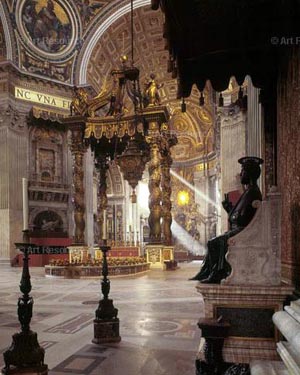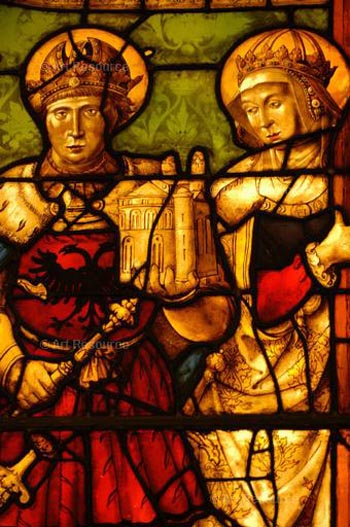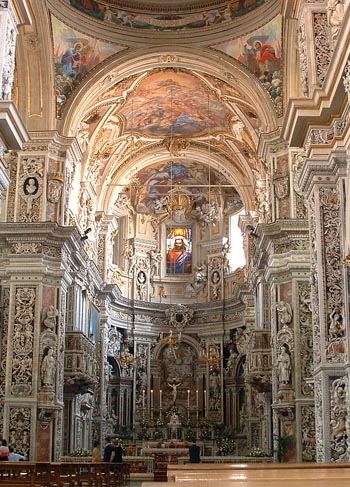About the Church
 |
 |
 |
 |
 |
 |
 |
The Constantinian vs. Miserablist Church
The example of St. Sylvester is quite opportune for the sad days in which we live. He was the Pope who lived in the time of Constantine and, therefore, presided over the transformation through which the Church passed.
She was in the darkness of night and came to live in the full light of the sun; she was persecuted as a slave and became the Queen; she left the catacombs and began to dwell in the palaces. Under St. Sylvester’s inspiration and command, the great work began of building the Church as an institution, as a sovereign religious society, the work which some call the “constantinization” of the Church.
The Constantinian Church
The progressivists created the term “Constantinian Church,” and from the adjective “constantinian” other words came, such as “constantinization,” “de-constantinization,” and even the verb “to constantinize.” What do the progressivists mean by these neologisms?
 First, Emperor Constantine made a decree giving liberty to the Catholic Church; later he issued another decree forbidding the false cults to carry on openly.
First, Emperor Constantine made a decree giving liberty to the Catholic Church; later he issued another decree forbidding the false cults to carry on openly.
Second, wanting to make amends for the unjust persecution the Church had undergone, Constantine gave his mother-in-law’s palace to the Church. This was the Laterani palace, and it became the first basilica of the Pope. It is the Basilica of St. John Lateran.
Third, he began to bestow special honors on the Bishops and treat them as official representatives of the Church.
Fourth, the acts of Catholic worship became more solemn because of Constantine’s presence at such ceremonies, which lent them the prestige of the Empire.
Fifth, he considered the Church to be united to the State.
And, sixth, when he changed the capital of the Roman Empire to Byzantium, soon called Constantinople, the Pope remained in Rome and became the virtual sovereign of the city. The Pope still did not have an official temporal power, but, practically speaking, he became the temporal lord of the city. These privileges with which Constantine honored the Catholic Church, and the natural development she experienced thenceforth, signify what the progressivists mean when they say the “Constantinian Church.”
 Therefore, the process of “constantinization” of the Church is two-fold:
Therefore, the process of “constantinization” of the Church is two-fold:
In the political sphere, it pronounced the Catholic Church as the only true Church. As such, the Church deserves to be protected, supported and respected by the State. Therefore, the Church is an entity more noble than the State and, at depth, given the fact that she is divine, more important than the State. From this principle came the medieval metaphor that the Church is the sun, and the State is the moon that turns around the sun and depends on it.
In the religious sphere, it upheld that the most splendid and magnificent earthly things and works of art were made first and foremost for the worship of God. So, the most magnificent incenses, the purest gold and silver, the most splendid fabrics and clothing should be made and reserved for the service of God.
This is the concept behind the “Constantinian Church.” Thus, the term circulated by the progressivists is in a certain sense objective, and we can understand it as referring to the temporal character of the Church, with her correlated richness and solemnity in worship, her sacral buildings, the pomp of her dignitaries, etc.
So, on one hand, we have the progressivists attacking the “Constantinian Church,” and, on the other, we have us defending it.
Combating the miserablist heresy
When St. Mary Magdalene used a splendid perfume to wash the feet of Our Lord and dry them with her hair, the first seed of the splendor of the future worship of Jesus Christ was sown. When Judas revolted against that act, saying that the perfume was too expensive, should be sold and the money given to the poor, he also was planting a seed, the seed of the progressivist position, which hates the solemn and rich worship.
Notwithstanding, Our Lord argued against Judas, saying that the poor will always be with us, and He defended the position of Mary Magdalene.
The position of the progressivists, therefore, is one that opposes temporal splendor for the Church. We call their ideal “miserablism” or the “miserablist Church.” According to this concept, the Church of Jesus is the church of the poor, a church made for the poor, and when she displays pomp and solemnity, she affronts the poor.
 Further, they defend she should be not only poor, but also miserable: she should present herself in a kind of misery. Therefore, religious edifices should resemble miserable abodes so that the poor do not feel uncomfortable in them. According to this mentality, Jesus Christ would have hated luxury and wealth; therefore, pomp, solemnity and the use of expensive objects should not exist in the house of God.
Further, they defend she should be not only poor, but also miserable: she should present herself in a kind of misery. Therefore, religious edifices should resemble miserable abodes so that the poor do not feel uncomfortable in them. According to this mentality, Jesus Christ would have hated luxury and wealth; therefore, pomp, solemnity and the use of expensive objects should not exist in the house of God.
Not only should poverty dominate in worship, but the Church should also be denied any special treatment, honor or protection from the State. She should be like any other society.
The thinking behind this is clear: Since the poor do not have wealth, luxury and honors, then no one should have them, not even God.
It is egalitarianism in its most monstrous aspect - because it goes further than demanding equality between poor and wealthy men, but calls for equality between the poor and God, which is absurd, since God is infinitely greater and more than all men, including the wealthy ones. This, then, is the thinking of the progressivists, which is the same as that of Judas Iscariot.
Applying this thinking to the Church, the progressivist current promotes the auto-destruction of the Catholic Church. It also wants to extirpate all the veneration the different peoples pay to the Church. Progressivists would like to strip this reverence from the very souls of the Catholic peoples.
On our part, we should know and understand what the progressivists mean when they attack the Constantine Church, and then we should love those temporal characteristics that they hate. For, throughout History, this is how the Holy Catholic Church was, is and will be. Temporal splendor is a necessary part of the one true Church of Jesus Christ.
Here let us recall that the man who “constantinized” the Church was St. Sylvester, a Pope and a saint canonized by the Church. If a Pope of our days (1966) were to say that the Catholic Church should be “de-constantinized,” he would be acting directly against what St. Sylvester did. We can imagine the furor of St. Sylvester against such a Pope if he were to return to earth and witness what was happening to the work he initiated.
This should also be our position against these blasphemous despoilers of the One, Roman, Apostolic, Catholic Church.

Posted May17, 2013
She was in the darkness of night and came to live in the full light of the sun; she was persecuted as a slave and became the Queen; she left the catacombs and began to dwell in the palaces. Under St. Sylvester’s inspiration and command, the great work began of building the Church as an institution, as a sovereign religious society, the work which some call the “constantinization” of the Church.
The Constantinian Church
The progressivists created the term “Constantinian Church,” and from the adjective “constantinian” other words came, such as “constantinization,” “de-constantinization,” and even the verb “to constantinize.” What do the progressivists mean by these neologisms?

The Chair of St. Peter in the Vatican Basilica rests over the grave of Pope St. Sylvester
Second, wanting to make amends for the unjust persecution the Church had undergone, Constantine gave his mother-in-law’s palace to the Church. This was the Laterani palace, and it became the first basilica of the Pope. It is the Basilica of St. John Lateran.
Third, he began to bestow special honors on the Bishops and treat them as official representatives of the Church.
Fourth, the acts of Catholic worship became more solemn because of Constantine’s presence at such ceremonies, which lent them the prestige of the Empire.
Fifth, he considered the Church to be united to the State.
And, sixth, when he changed the capital of the Roman Empire to Byzantium, soon called Constantinople, the Pope remained in Rome and became the virtual sovereign of the city. The Pope still did not have an official temporal power, but, practically speaking, he became the temporal lord of the city. These privileges with which Constantine honored the Catholic Church, and the natural development she experienced thenceforth, signify what the progressivists mean when they say the “Constantinian Church.”

Constantine holds the Lateran Church, his mother St. Helen, at right, gave the Church many other buildings
In the political sphere, it pronounced the Catholic Church as the only true Church. As such, the Church deserves to be protected, supported and respected by the State. Therefore, the Church is an entity more noble than the State and, at depth, given the fact that she is divine, more important than the State. From this principle came the medieval metaphor that the Church is the sun, and the State is the moon that turns around the sun and depends on it.
In the religious sphere, it upheld that the most splendid and magnificent earthly things and works of art were made first and foremost for the worship of God. So, the most magnificent incenses, the purest gold and silver, the most splendid fabrics and clothing should be made and reserved for the service of God.
This is the concept behind the “Constantinian Church.” Thus, the term circulated by the progressivists is in a certain sense objective, and we can understand it as referring to the temporal character of the Church, with her correlated richness and solemnity in worship, her sacral buildings, the pomp of her dignitaries, etc.
So, on one hand, we have the progressivists attacking the “Constantinian Church,” and, on the other, we have us defending it.
Combating the miserablist heresy
When St. Mary Magdalene used a splendid perfume to wash the feet of Our Lord and dry them with her hair, the first seed of the splendor of the future worship of Jesus Christ was sown. When Judas revolted against that act, saying that the perfume was too expensive, should be sold and the money given to the poor, he also was planting a seed, the seed of the progressivist position, which hates the solemn and rich worship.
Notwithstanding, Our Lord argued against Judas, saying that the poor will always be with us, and He defended the position of Mary Magdalene.
The position of the progressivists, therefore, is one that opposes temporal splendor for the Church. We call their ideal “miserablism” or the “miserablist Church.” According to this concept, the Church of Jesus is the church of the poor, a church made for the poor, and when she displays pomp and solemnity, she affronts the poor.

Above, the magnificent Palermo Cathedral where everything gives glory to God; below, a progressivist miserablist church stripped of beauty and pomp

Not only should poverty dominate in worship, but the Church should also be denied any special treatment, honor or protection from the State. She should be like any other society.
The thinking behind this is clear: Since the poor do not have wealth, luxury and honors, then no one should have them, not even God.
It is egalitarianism in its most monstrous aspect - because it goes further than demanding equality between poor and wealthy men, but calls for equality between the poor and God, which is absurd, since God is infinitely greater and more than all men, including the wealthy ones. This, then, is the thinking of the progressivists, which is the same as that of Judas Iscariot.
Applying this thinking to the Church, the progressivist current promotes the auto-destruction of the Catholic Church. It also wants to extirpate all the veneration the different peoples pay to the Church. Progressivists would like to strip this reverence from the very souls of the Catholic peoples.
On our part, we should know and understand what the progressivists mean when they attack the Constantine Church, and then we should love those temporal characteristics that they hate. For, throughout History, this is how the Holy Catholic Church was, is and will be. Temporal splendor is a necessary part of the one true Church of Jesus Christ.
Here let us recall that the man who “constantinized” the Church was St. Sylvester, a Pope and a saint canonized by the Church. If a Pope of our days (1966) were to say that the Catholic Church should be “de-constantinized,” he would be acting directly against what St. Sylvester did. We can imagine the furor of St. Sylvester against such a Pope if he were to return to earth and witness what was happening to the work he initiated.
This should also be our position against these blasphemous despoilers of the One, Roman, Apostolic, Catholic Church.

Posted May17, 2013











